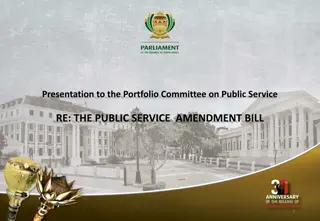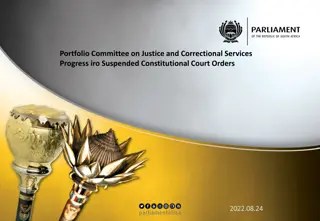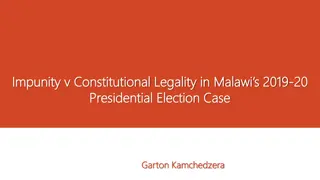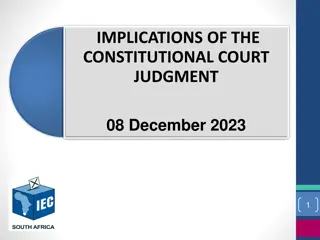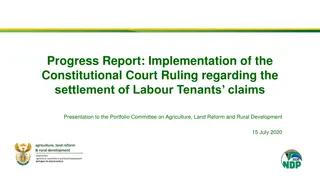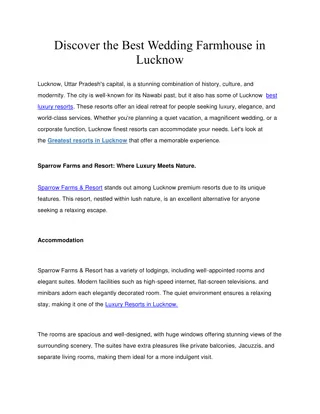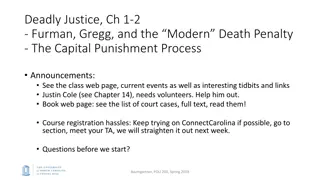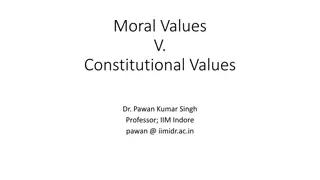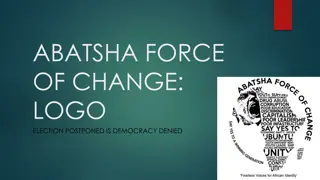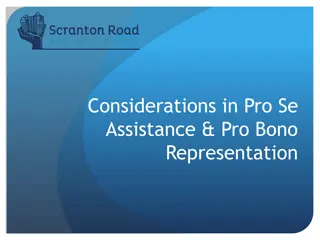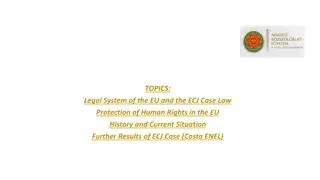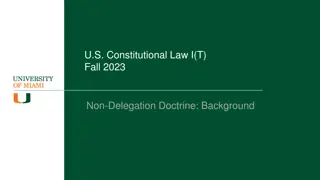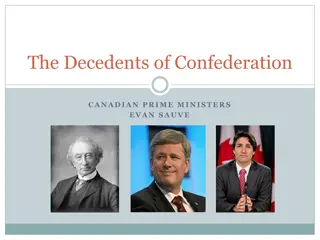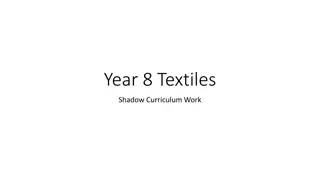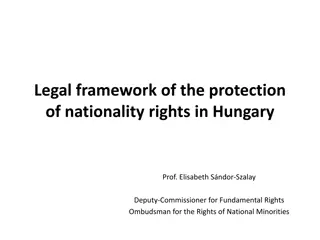Understanding the Constitutional Background of Sparrow Case
Providing a comprehensive contextual understanding of the Sparrow case is crucial beyond just teaching the basic interpretive framework. The historical background of Sparrow, rooted in colonial imperialism and Indigenous sovereignty, shapes the constitutional rationale behind the interpretation of s. 35 and s. 91(24). By delving into this background, students can grasp the deeper constitutional principles at play, anticipate legal developments, and challenge the legacy of colonialism in Canadian constitutional law.
Download Presentation

Please find below an Image/Link to download the presentation.
The content on the website is provided AS IS for your information and personal use only. It may not be sold, licensed, or shared on other websites without obtaining consent from the author. Download presentation by click this link. If you encounter any issues during the download, it is possible that the publisher has removed the file from their server.
E N D
Presentation Transcript
TEACHING S. 91(24) AND S. 35: SPARROW S BACKGROUND By Dr. J. B. D. Nichols
The Challenge: Providing Context for Federal Power in Sparrow Sparrow is the foundational case for s. 35 and thus is often taught separately from s. 91(24). Given the condensed nature of constitutional law there is an understandable tendency to focus on teaching the basic interpretive framework that the case established. This approach makes a certain degree of sense, as it provides students with a formal understanding of the test that the court develops, but this formalistic approach has distinct limitations. T he foremost of these limitations is that it provides no understanding of the constitutional rationale for the test itself. The constitutional rationale for the interpretation of s. 35 that the Court puts forward is based on what they refer to as the background of s. 35 and this background includes s. 91(24) and the history of colonial imperialism. It is this background that provides them with the justification for applying an Oakes-like s. 1 analysis to a provision of the Constitution Act, 1982 that is not actually in the Charter. If we only teach the foreground of Sparrow and expect students to simply be able to apply the test on an exam, then we have ultimately failed to provide them with the constitutional background that gives that test any meaning. Further, without an understanding of the historical background they will fail to grasp the deeper constitutional principles that are drawn into tension in s. 35 litigation and actually drive the jurisprudence. In sum, without a grasp of the background of Sparrow that extends beyond that put forward by the Court students will lack the basic contextual knowledge that would allow them to either interpret the significance of specific changes in the law or forecast the possibility of new developments and ultimately we have contributed to continuing the legacy of colonial imperialism in Canadian constitutional law.
Whats in Sparrows Background? The Canadian courts have struggled and continue to struggle with the legacy of colonialism. There are a series of cases that have relied on colonial legal doctrines that diminish the legal standing of Indigenous peoples by appeal to a hierarchy of civilizations. In these cases, the courts recognize the colonial version of Crown sovereignty, which allows them to posit that the assertion of Crown sovereignty stripes Indigenous peoples both their political existence and their lands. The Court has recognized that section 35(1) of the Constitution Act, 1982, represents the culmination of a long and difficult struggle in both the political forum and the courts for the constitutional recognition of aboriginal rights (Sparrow at 1105). Despite this the Sparrow Court went on to hold that there was from the outset never any doubt that sovereignty and legislative power, and indeed the underlying title, to such lands vested in the Crown (Sparrow at 1103). This statement establishes the background that allows the Court to reconcile federal power under s. 91(24) with the federal duty that is recognized and affirmed in s. 35. The obvious problem with this background is there no legal explanation for the disappearance of Indigenous sovereignty and this brings it into tension with the Court s prior rejection of colonial doctrines that dimmish the legal capacity of Indigenous peoples. For example, as Dickson J (as he was then) stated in Simon v. The Queen the colonial doctrines of civilizational hierarchy that Justice Patterson relied on in R v Syliboy reflect the biases and prejudices of another era of our history and that [s]uch language is no longer acceptable in Canadian law. (Simon v. The Queen, [1985] 2 SCR 387 at 399).
Whats in Sparrows Background The thin (to the point of being nonexistent) basis for the background the Court articulates is apparent when we consider the precedents the Court relied on: the 1823 decision of the US Supreme Court in Johnson v M Intosh, the Royal Proclamation of 1763 and three specific pages from the Supreme Court of Canada s 1973 decision in Calder. The citations do not provide a clear and stable foundation for the Court s articulation of Crown sovereignty. It is not clear, for example, the precise principle the Court cites Johnson v M Intosh as supporting. Certainly, it would be a stretch to suggest that Johnson stands for the proposition that Indigenous peoples lost all sovereign and self-governing authority upon European discovery and that such discovery subject them to unfettered Crown regulatory authority. Yet, this seems to be the precise sense in which the Sparrow Court uses the case. Further, Johnson v M Intosh is the first case in the Marshall Trilogy and lays out a version of the doctrine of discovery that the subsequent two cases go on to reject. In addition, the specific pages cited from Calder include Hall J s move from Johnson v M Intosh to Worcester v Georgia and Judson J s statement that the origin of title does not come by way of European recognition, but the fact that when the settlers came, the Indians were there, organized in societies and occupying the land as their forefathers had done for centuries.
Whats at Stake in the Background? If the background set out in Sparrow is simply accepted, we are driven to conclude that the Crown has sovereignty, legislative power and underlying title, whereas s. 35 provides Charter-like protections a sui generis species of rights. This seems to fit with the Court s claim in the Secession Reference that s. 35 is an example of Canada s long tradition of protecting the rights of minorities. But this conclusion begs the question of what exactly happened to Indigenous sovereignty. In order to backfill this omission the courts have either recharacterized the treaties as surrender agreements or simply adopted colonial era legal fictions (like the so-called doctrine of discovery) to diminish the legal capacity of Indigenous peoples and thereby pave the way for the Crown s unilateral assertion of sovereignty as having the effect of locking Indigenous peoples into a constitutional straightjacket that they can only leave if they are able to avail themselves of democratic institutions that were imposed upon them. Neither of these options provide a solution to the problem, rather they add in the troubling notion that the courts are providing the color of legality to the Crown s unilateral assertion of sovereignty over Indigenous peoples. Such a move necessarily brings us into what David Dyzenhaus has referred to as a grey hole in the constitutional order. It is concerning not only because of the negative effects it has had on Indigenous peoples but also on the form of sovereign authority that it necessarily attributes to the Crown that is the ability to declare sovereignty over other peoples and thereby dissolve their national character without being subject to judicial review. This is the kind of absolute sovereign authority that both the Glorious Revolution of 1688 and later the American Revolutionary War in 1775 were reacting against and this rejection forms the core principles of the constitutional tradition that Canada has inherited. Simply put, the stakes of failing to teach the background of Sparrow are nothing less than the rule of law.
How to Remedy the problem in Constitutional Legal Education? How are we to remedy this problem? While I cannot claim to have a complete answer, I do have a few suggestions that I think would help move legal education towards a decolonized understanding of our constitutional order. 1. A historical and contextual approach to s. 91(24) of the British North America Act, 1867. Such an approach requires the following: A balanced understanding of the history of the pre-confederation period as seen by the Imperial Crown, local colonists and Indigenous peoples. A more detailed view of the post-1812 changes in Imperial administration and the process of unilateral legislative devolution to the colonies. This must include the legislative history of the pre-cursors of the Indian Act (e.g. the Gradual Civilization Act and Gradual Enfranchisement Act). This should cover the rise of scientific racism in the 19thcentury and its use by key British constitutional thinkers like J. S. Mill and its use in jurisprudence (e.g., Kagama, St. Catharine s Milling, Syliboy, etc.) A principled common law legal analysis of what s. 91(24) could mean given the historical relationship between Indigenous peoples and the Imperial crown. This should involve a review of Chief Justice Marshall s decisions in Johnson v. M Intosh, Cherokee Nation and, most importantly, Worcester. A clear review of the decision of Chancellor Boyd in St. Catharine s Milling and its continuing implications. This review should show his explicit use of the savagery thesis and the endorsement of his reasons in Lord Watson s decision. This should include a history of the cases that explicitly maintained this colonial approach until Calder in 1973 and how this legacy continues on to this day in the problem of how Indigenous sovereignty is explained away.
How to Remedy the problem in Constitutional Legal Education? 2. A principled account of the basis and meaning of the honor of the Crown. Such an approach requires the following: The basis of the honor of the Crown is the assertion of sovereignty: the honor of the Crown arises from the Crown s assertion of sovereignty over an Aboriginal people and de facto control of land and resources that were formerly in the control of that people (Haida Nation, at para. 32). As the Court stated in Manitoba Metis Federation Inc. v. Canada (Attorney General), [2013] 1 SCR 623 at para. 66 the honour of the Crown goes back to the Royal Proclamation of 1763, which made reference to the several Nations or Tribes of Indians with whom We are connected, and who live under our Protection : see Beckman v. Little Salmon/Carmacks First Nation, 2010 SCC 53, [2010] 3 S.C.R. 103, at para. 42. This Protection , though, did not arise from a paternalistic desire to protect the Aboriginal peoples; rather, it was a recognition of their strength. Nor is the honour of the Crown a paternalistic concept. The trust-like relationship is not paternalistic: Properly understood the honor of the Crown thus reflects both the fact that the relationship between Indigenous peoples and the Crown to one of equal partnership (see Report of the Royal Commission on Aboriginal Peoples, at pp. 3, 10 and 40-41) and that Indigenous legal traditions are among Canada s legal traditions. They form part of the law of the land. (Pastion v. Dene Tha First Nation, [2018] 4 FCR 467 at para. 9).
How to Remedy the problem in Constitutional Legal Education? Indigenous peoples and the Crown share sovereignty: The nature of this partnership is described in the final Report of the Royal Commission on Aboriginal Peoples, vol. 2, as shared sovereignty at pp. 240-41 Shared sovereignty, in our view, is a hallmark of the Canadian federation and a central feature of the three-cornered relations that link Aboriginal governments, provincial governments and the federal government. These governments are sovereign within their respective spheres and hold their powers by virtue of their constitutional status rather than by delegation. Nevertheless, many of their powers are shared in practice and may be exercised by more than one order of government. The concept of shared sovereignty is instructive as it helps to clarify what the Court in Sparrow meant when it stated that the relationship between the Crown and Indigenous peoples is trust-like, rather than adversarial (Sparrow, at 1108). The clarification is provided by the fact Indigenous peoples are sovereign by virtue of their constitutional status rather than by delegation. Justice Binnie rightly summarizes the nature of the concept of shared sovereignty in Mitchell v. M.N.R., [2001] 1 S.C.R. 911 at para. 130 as being partnership without assimilation. In sum, the honour of the Crown recognizes the impact of the superimposition of European laws and customs on pre- existing Aboriginal societies (R. v. Van der Peet, [1996] 2 S.C.R. 507, at para. 248, per McLachlin J., dissenting; cited with approval in Manitoba Metis Federation Inc. v. Canada (Attorney General), 2013 SCC 14 at para. 67) and it responds to this colonial practice of assimilation by imposing a heavy obligation on the Crown to reconcile with Aboriginal peoples as equals in confederation (Ibid, at para 68). The substantial meaning of this equality is based in the fact that the assertion of Crown sovereignty must be reconciled with the fact remains that Aboriginal peoples were here first, and they were never conquered (Haida Nation, at para. 25). Thus, the terms occupation and trust-like cannot be understood as diminishing the status of Aboriginal peoples as sovereign peoples, to do so would be to conflate partnership with assimilation.
How to Remedy the problem in Constitutional Legal Education? 3. The Secession Reference should be taught in conjunction with Sparrow via a problem-based approach. Such an approach requires the following: The practical limitations of the Sparrow Framework: The Sparrow framework has not facilitated a process of constitutional negotiation. Instead by viewing s. 35 rights as being analogous to those in the Charter it has placed the parties on unequal footing. The fact that unilateral infringement remains possible has led to a situation where the Crown engages in consultation with the resources to litigate to achieve its policy goals. Whereas Indigenous peoples have had to spend many years and considerable resources litigating simply to prove that these rights continue to exist. In other words, consultation and litigation have taken the place of honorable negotiation and this has resulted in a situation wherein [t]he burden of achieving reconciliation is thereby placed upon the one group of Canadians whose assertion of sovereignty is not what demands reconciliation with anyone or anything (Mikisew Cree First Nation v. Canada (Governor General in Council), [2018] 2 SCR 765 at para. 142). As Justice Abella states, While the judiciary must respect the separate roles of each institution in our constitutional order, its own role is to maintain the rule of law and protect the rights guaranteed by the Constitution. It would be a mistake, in my respectful view, to interpret parliamentary sovereignty in a way that eradicates the obligations under the honour of the Crown that arose at its assertion. Like all constitutional principles, parliamentary sovereignty must be balanced against other aspects of our constitutional order, including the duty to consult. Sovereign will alone does not itself indicate legitimacy in the context of a constitutional democracy characterized by competing values, rights, and obligations. (Ibid, at para. 91 (citations omitted))
How to Remedy the problem in Constitutional Legal Education? The Secession Reference shows that there is a coherent and principled way to move from Sparrow s Charter-like rights to a Jurisdictional understanding of s. 35 The Secession Reference provides a basis for the negotiated resolution of outstanding issues. Because the Court in the Secession Reference recognized that it was dealing with jurisdictional disputes between initial members of Confederation who were involved in the act of nation-building , it applied the tools appropriate to that circumstance (Secession Reference at 43). The problem in the Secession Reference is that Indigenous peoples were categorized as a minority within Canada (Ibid). Their contribution to the building of Canada was thus diminished without explanation (Ibid, at 82). But this error can be remedied by rejecting the colonial understanding of the fiduciary relationship between Indigenous peoples and the Crown. Once the relationship is seen in the correct light it is clear that Indigenous peoples are also initial members of Confederation . The model of reconciliation put forward in the Secession Reference honors the Indigenous-Crown relationship by requiring negotiation to maintain the legitimacy of the constitutional order. In contrast, the in Sparrow the court recognized the Crown s claims to a colonial conception of sovereignty that diminishes the legal standing of Indigenous peoples to that of a cultural minority. Sparrow s model of reconciliation begins with a constitutional imbalance and can only provide an unbalanced negotiating table. By bringing the principles of the Secession Reference to bear on Crown-Indigenous disputes the court would impose a duty to negotiate outstanding claims based upon the honor the Crown a duty that takes unilateralism out of the toolkit of all parties and require that the conduct of the parties in such negotiations would be governed by the same constitutional principles which give rise to the duty to negotiate: federalism, democracy, constitutionalism and the rule of law, and the protection of minorities. (Secession Reference at para. 90)




